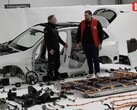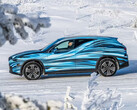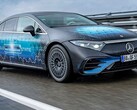The new 2027 Mercedes GLC that will be released in the US in the second half of 2026 comes with a number of firsts for its premium electric SUV class.
Apart from being the first with a certified vegan interior and carrying the largest 39.1-inch pillar-to-pillar Hyperscreen Mercedes has ever put in one of its vehicles, the GLC will come with a modular battery that can actually be serviced and repaired easily.
Modern EV battery architecture increasingly comes in a sealed cell-to-pack (CTP) form, or the so-called structural battery, whose cells become an integral part of the chassis support structure. This approach offers several price advantages, as the EV chassis serves as battery cover, while the space between the cells is simply filled with copious amounts of impossible to remove adhesive, as a Model Y 4680 battery unit teardown demonstrated.
Using a structural battery pack is much cheaper for the manufacturer than a standalone modular battery, but it also means that the pack is prohibitively expensive to replace or to service if only individual cells fail.
Whether forced by new European regulations about making batteries in electronic devices swappable, or due to internal conviction, Mercedes decided to offer the new GLC with the type of modular battery architecture pioneered in the GLA. Having a battery that is easy to repair or replace will be quite the advantage for the Mercedes GLC before the new BMW iX3 and even Tesla SUVs like the Model Y.
The 94 kWh battery pack that will propel the GLC for more than 300 miles of EPA estimated range comes in a dedicated housing, while its cover is fastened with screws, not glued with hard to pry open or assemble back adhesive. This way, when the battery warranty expires, future GLC owners may be able to replace only individual cells or modules. This type of service is much cheaper than replacing the whole battery and will allow the new electric Mercedes to retain its value longer than typical for a second-hand EV.
Moreover, the battery electronics are housed in a separate module that is easily accessible from below the vehicle, instead of having to disassemble the whole pack like with CTP solutions. Battery diagnostics can thus be carried out quickly to determine which modules have failed and replace only what's needed, "a decisive factor for the long-term operation of electrified vehicles," boasts the GLC presser.
Mercedes engineers have a point, as the world's largest EV battery maker CATL recently rang the alarm over the growing number of electric vehicles coming with cheap but hard to service cell-to-pack battery technology. The architecture, argued CATL, makes replacing an EV battery after its usable life prohibitively expensive to the point where the remaining vehicle value is less than the price of a new battery, making replacements nearly pointless.
CATL is now working with a subsidiary to provide cheap structural battery repairs that only replace individual cells that have failed at 10% of the cost of a whole battery swap, hoping to create an actually viable second-hand EV market. Solutions like the modular battery architecture of the new Mercedes GLC, however, may be more suitable for premium electric vehicles which may carry a high initial price and won't be as disposable as a mass market EV with sealed CTP battery.
















